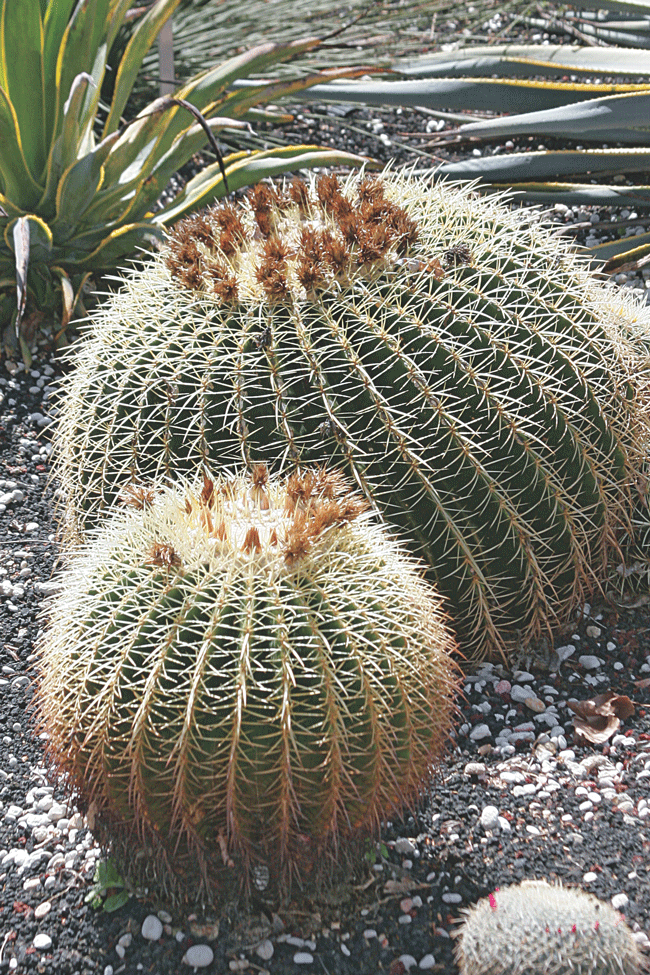
Golden Barrel Cactus
Echinocactus grusonii
Care & Maintenance
Plant Code:
L11717
Light:
Full Sun - 6+ Hours Direct Sun
Water:
Low, once established
Bloom Time:
Summer
Flower Color:
Yellow
Average Size:
3-6' H x 3-6' W
Spacing:
3-6'
Cold Hardiness:
Zone 9 (30 to 20°F)
About This Plant
Cactus and Succulents are tough, adaptable plants that will grow with minimal care once they are established. Many of these plants store water by using enlarged stems or leaves and live in environments where water is limited. These characteristics make cactus and succulents great for container gardens and arid landscapes. Their interesting form, texture or color will provide a welcome accent to any garden.
Additional Information
Requires porous, fast draining soil.
Uses
Container, Rock Garden, Specimen
Attributes
- Large, rounded cactus
- Vivid yellow summer flowers
- Little to no maintenance
- Ideal for rock gardens
How to Water
- Before watering cacti and succulents in containers, check the weight of the container if possible. A dry pot will weigh much less than one that is moist. If you are unable to lift the container, place a wooden stick in the soil and push it all the way to the bottom of the container. Leave the stick there for a while. If the stick is moist upon removal, there is no need to water. If water is necessary, thoroughly drench the soil and allow all excess water to drain completely from the container. Never let a cactus or succulent stand in water for any length of time.
- For cacti and succulents planted in the ground, water thoroughly with a deep soaking every couple of weeks or so depending on weather and time of year; more often in hot dry summers or less often during rainy seasons and winter dormancy. Once they are established they can go longer without water.
- Carefully plan the placement of plants in the landscape to fully maximize outdoor irrigation systems.
- These plants can be environmentally friendly because they require less water to survive.
How to Plant
- Prepare the area for planting by conditioning the soil. Use a well-drained, cactus and succulent planting mix.
- When planting in the ground, dig a small hole in the planting mix and place the plant in the hole just deep enough to cover the roots so the surface of the soil from the original pot is level with the soil of the new location. Fill in the hole with the planting mix and gently firm in place.
- For containers, line the bottom of the container with about an inch of pebbles or lava rock and cover with a cactus and succulent potting mix. Dig a small hole in the planting mix and place the plant in the hole just deep enough to cover the roots so the surface of the soil from the original pot is level with the soil of the new container. Fill in the hole with the planting mix and gently firm in place.
- In either case, allow the soil to remain dry for 3-4 days before watering to allow any damaged roots to heal over, then water thoroughly. Add more soil mix around plant if necessary due to settling after watering.
How to Fertilize
- Cacti and succulents are not heavy feeders, but can be fertilized once a month during the plants active growing cycle beginning in the spring when temperatures start warming up and the fear of frost is over.
- Fertilizing should end three or four weeks before the end of the growing season before autumn.
- Choose a fertilizer recommended for cacti and succulents and follow the package directions, or choose any all purpose, balanced liquid fertilizer and mix it to ¼ strength of what the directions indicate.
How to Prune
- Cacti rarely require pruning whereas some succulents can use an occasional trim.
- Damaged leaves or branches should be removed, and if necessary, prune as required to keep plants a desired size or shape.
- Paddle or jointed type cacti should be cut at the joint between paddles to remove unwanted ones. Columnar cacti types usually don’t need pruning.
- Most trailing, upright, or branching succulents can be trimmed as desired usually creating a more compact, fuller growth habit.
- Use proper tools such as clippers, hand pruners, pole pruners and pruning saws. Make sure all equipment is clean and sharp.


 We could not acquire a location at this time.
We could not acquire a location at this time.


